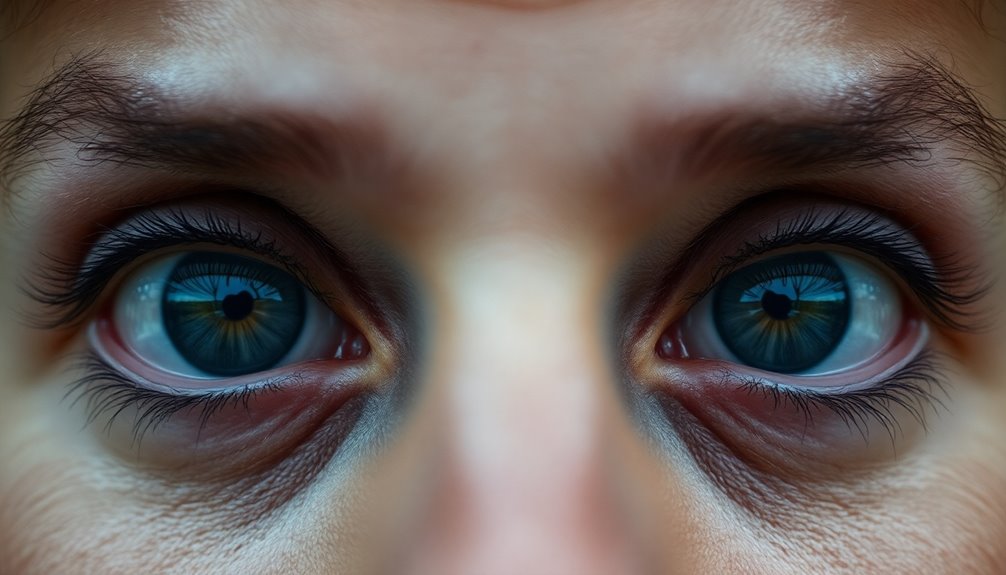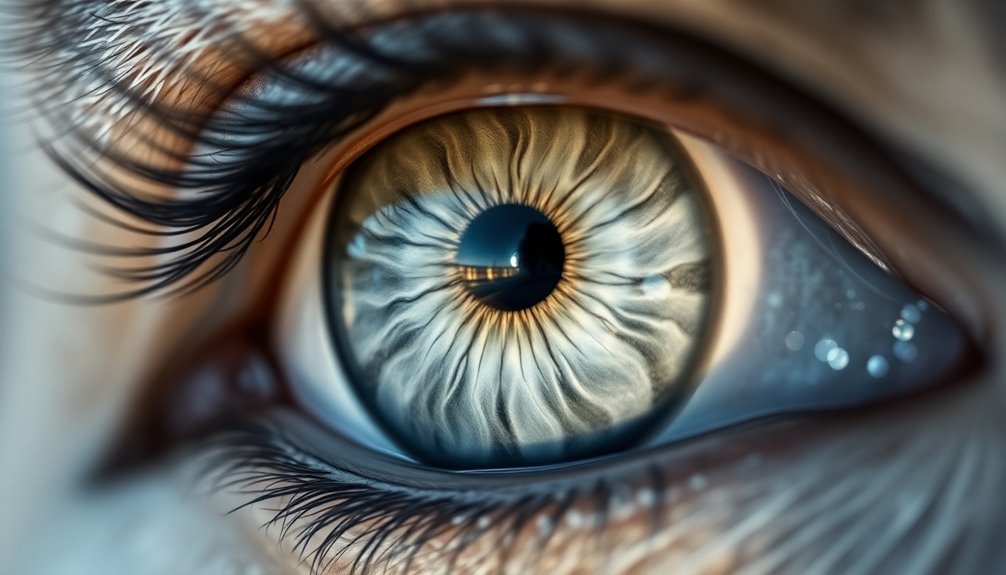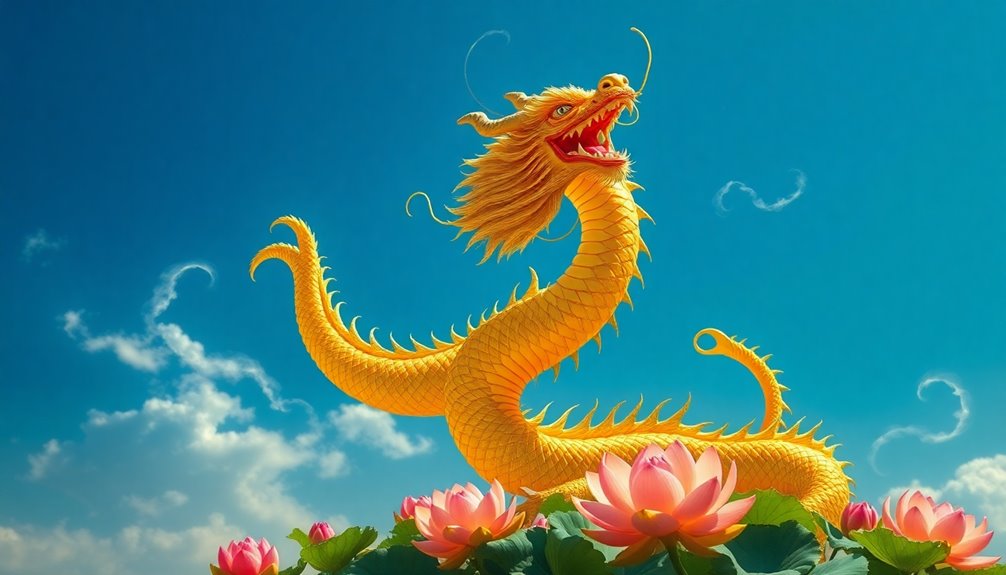Grey eyes symbolize a unique blend of wisdom, resilience, and a deeper spiritual insight. You'll find that these captivating eyes reflect intellectual depth and an ability to analyze situations thoughtfully. Their rarity, seen in less than 1% of the population, adds to their allure. Grey-eyed individuals often maintain calmness in chaos, embodying a sense of stability that draws others in. This hue is linked to clairvoyant abilities, enhancing one's perception of the future. Embrace the mystery of grey eyes, and you'll uncover even more intriguing meanings associated with this striking eye color and its bearers.
Key Takeaways
- Grey eyes symbolize wisdom and intellectual depth, often reflecting thoughtful and analytical approaches to life.
- They are associated with inner strength and resilience, aiding individuals in overcoming life's challenges.
- Grey eyes represent spiritual neutrality, promoting calmness and stability in chaotic situations.
- Rarity in the global population enhances their allure, often linked to prophetic abilities and spiritual guidance.
- Individuals with grey eyes typically exhibit strong communication skills and a composed demeanor, fostering confidence in leadership roles.
Spiritual and Mystical Associations

Grey eyes carry profound spiritual and mystical associations that can shape one's perception of the world. If you possess grey eyes, you might find yourself connected to clairvoyant abilities, enabling you to see into the future or read the energies around you. This gift often comes hand in hand with inner strength and resilience, allowing you to navigate life's challenges with grace.
Your grey eyes may also reflect an intellectual depth, making you thoughtful and analytical. You likely approach situations with a sense of spiritual neutrality, seeing both sides and maintaining calmness in chaotic environments. This balance may position you as a mentor or seer in spiritual contexts, someone others turn to for wisdom and guidance. Additionally, grey-eyed individuals are often seen as possessing strong prophetic abilities, enhancing their role as guides in spiritual matters.
Moreover, your grey eyes could symbolize a direct line to the divine, enhancing your connection to otherworldly realms and deeper spiritual truths. You may even possess healing powers, radiating a cool, strong-willed energy.
Ultimately, grey eyes not only signify your unique spiritual abilities but also serve as a reminder of your role in bridging the mystical and the mundane, helping you navigate life's complexities with insight and poise.
Cultural and Historical Perspectives
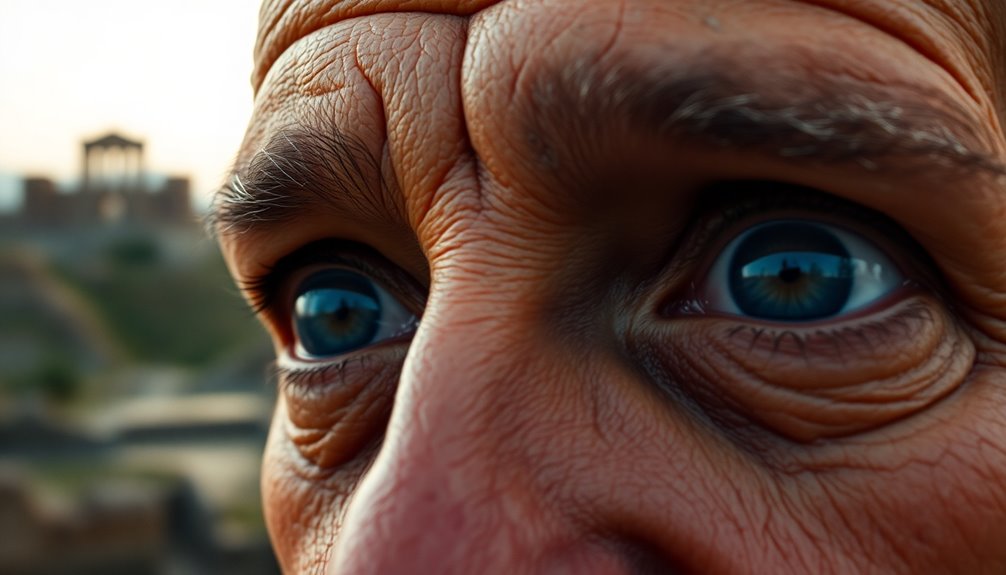
Exploring the cultural and historical perspectives of grey eyes reveals a rich tapestry of meanings and associations. In ancient Greece, grey eyes were linked to Athena, the goddess of wisdom and war, cementing their connection to intelligence. This association has influenced various cultures, where grey eyes symbolize wisdom, neutrality, and calmness. You'll find that in literature, characters with grey eyes often possess profound knowledge, reinforcing the idea of insight and awareness.
Historically, the first iris color classification scale from 1843 included grey as a distinct category, highlighting its significance. Superstitions also play a role; men with grey eyes are sometimes seen as more faithful, while women with the same eye color can be viewed as greedy. Less than 1% of the global population have grey eyes, which adds to their mystique and rarity.
These conflicting narratives illustrate the complexity of cultural perceptions. Moreover, grey eyes are often seen as indicators of a balanced temperament, reflecting stability and deep insight. As you delve deeper into the lore surrounding grey eyes, you'll encounter a spectrum of interpretations, from positive traits like wisdom to negative qualities, showcasing the multifaceted nature of this eye color throughout history and culture.
Genetic and Physical Features
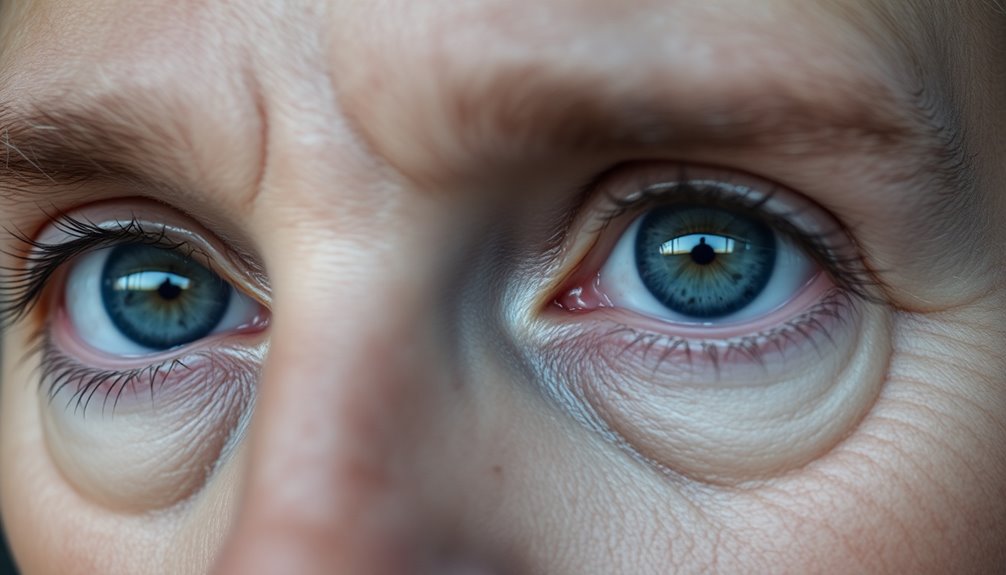
A fascinating aspect of grey eyes lies in their genetic and physical features, which stem from a complex interplay of multiple genes. You're looking at a polygenic trait influenced by several genes, notably the OCA2 and HERC2 genes. These genes impact pigment production, resulting in reduced melanin in your iris, which gives grey eyes their unique hue.
The SLC24A4 gene also plays a role, affecting ion transportation related to pigmentation.
In terms of melanin content, grey eyes have less melanin than brown eyes but more than blue eyes, striking a balance between eumelanin and pheomelanin. This distribution not only influences your eye color but also how light interacts with your eyes. The architecture of the iris, particularly the collagen fibers in the stroma, scatters light, enhancing the grey appearance.
Interestingly, grey eyes are among the rarest human eye colors in the world, occurring in less than 1% of the global population. You'll notice that grey eyes can appear to change color under different lighting conditions, sometimes looking blue or green. Additionally, lower melanin levels mean you might be more sensitive to bright light.
Symbolic Meanings of Grey Eyes
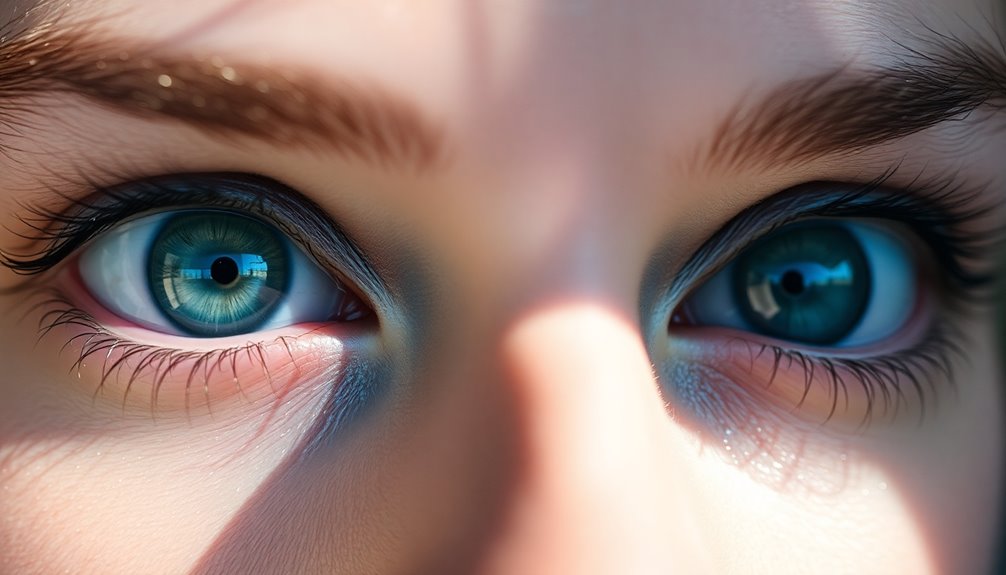
The unique genetic and physical attributes of grey eyes not only make them visually striking but also imbue them with rich symbolic meanings across various cultures. When you encounter someone with grey eyes, you might notice that they often exude a sense of wisdom and knowledge. In many traditions, grey eyes are linked to the goddess Athena from Greek mythology, symbolizing insight and intelligence.
You'll find that grey eyes are also associated with calmness and neutrality. This unique eye color can reflect a balanced mood and a composed temperament, making those who possess them appear stable and thoughtful. Interestingly, less than 1% of the global population has gray eyes, which adds to their allure and symbolic significance.
In literature and art, characters with grey eyes frequently embody profound knowledge, enhancing their enigmatic allure. Moreover, across different cultures, grey eyes can symbolize both wisdom and mystery, capturing the fascination of many.
Although some interpretations may suggest negative traits, the overall perception leans towards admiration for their rarity and captivating nature. Ultimately, grey eyes provide a glimpse into a world of depth, sophistication, and insight, making them a remarkable feature in any individual.
Psychological and Behavioral Traits
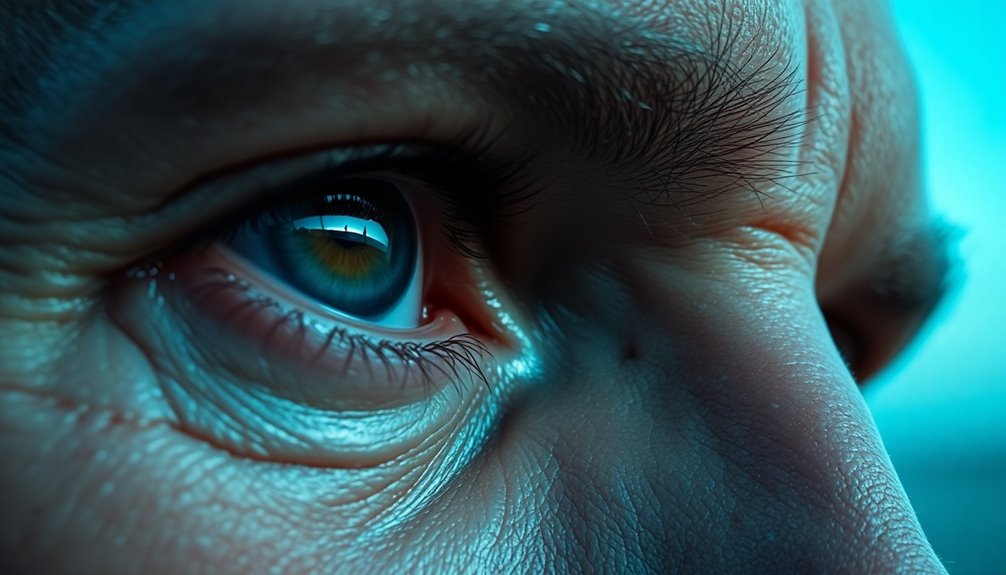
Grey-eyed individuals often display a unique blend of psychological and behavioral traits that set them apart. You might find that these individuals possess strong analytical and logical thinking skills, often approaching problems with a calm demeanor and critical mindset. Their ability to remain composed under pressure makes them excellent strategists and planners. This is reflected in their strong connection to wisdom, which allows them to make informed decisions in high-stakes situations. Additionally, their proactive nature helps them to tackle challenges head-on, further enhancing their decision-making abilities. Understanding the importance of self-care practices can further enhance their resilience during stressful periods, as a strong foundation in emotional regulation can significantly impact their well-being. Furthermore, their subconscious power can be harnessed to facilitate better emotional balance.
Emotionally, grey-eyed people tend to be calm and organized, which can make you feel confident in their leadership abilities. While they may appear reserved, they often shine in the right environment, displaying a sensitive side that shows empathy toward others. Their strong intuition allows them to navigate social dynamics effectively, akin to how socialization fosters essential interpersonal skills.
In work and life, you'll notice their hard-working nature and high tolerance for challenges. They take life seriously, often preferring to avoid frivolity.
Even though they maintain a strong exterior, they're capable of forming stable relationships, driven by their intelligence and curiosity.
Ultimately, grey-eyed individuals provide a sense of stability to those around them, making them both desirable and attractive companions. Their unique traits contribute to a mysterious aura that intrigues others, while their communication skills ensure they're often heard, even if it takes time for them to express themselves.
Health and Environmental Factors
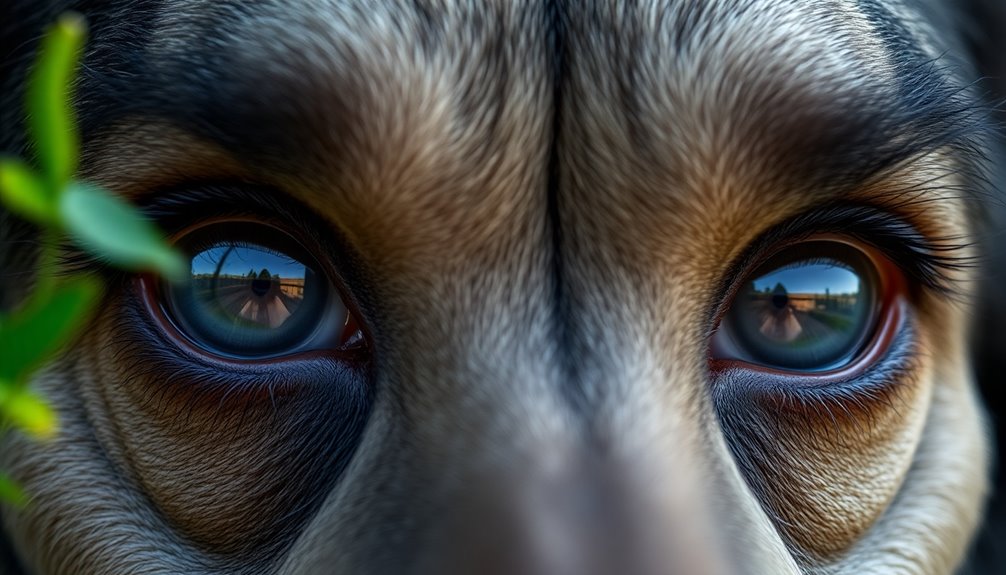
Considering health and environmental factors, individuals with grey eyes face a unique set of risks and advantages. On one hand, you may be at a higher risk for ocular melanoma due to the lower melanin levels in your iris. However, you also enjoy a reduced likelihood of autoimmune diseases like vitiligo and lupus.
It's essential to stay vigilant about your eye health, especially since conditions like cataracts can also give your eyes a greyish appearance. Your grey eyes are more sensitive to sunlight, increasing the risk of damage from UV rays. To protect your vision, wearing UV-blocking sunglasses is a must. Furthermore, the unique appearance of grey eyes is partly due to the collagen in the iris that reflects light.
Remember, prolonged sun exposure might even alter the perceived color of your eyes over time. Genetically, grey eyes are influenced by the OCA2 and HERC2 genes, which regulate melanin production. Environmental factors, such as light exposure and age, can further change the appearance of your eyes.
Additionally, certain medications might cause a greyish tint, so consult your healthcare provider if you notice any unexpected changes. Being aware of these health and environmental factors can help you maintain the beauty and health of your grey eyes.
Frequently Asked Questions
Can Grey Eyes Change Color Over Time?
Yes, grey eyes can change color over time.
As you age, melanin levels in your eyes may fluctuate, causing them to appear lighter or darker.
Environmental factors like lighting and stress can also influence how your grey eyes look.
Additionally, lifestyle choices and health conditions may affect their hue.
Are Grey Eyes More Common in Certain Ethnic Groups?
Yes, grey eyes are more common in certain ethnic groups, particularly those of European descent.
You'll find them predominantly in Northern and Central Europe, especially in countries like Iceland, Ireland, and Sweden.
They're also observed in the Algerian Shawia people and some regions of the Middle East.
While grey eyes are rare globally, their concentration in these specific populations highlights the influence of genetics and ancestry on eye color distribution.
Do Grey Eyes Have Any Impact on Personality Traits?
Yes, grey eyes can impact personality traits.
If you have grey eyes, you might be perceived as wise and analytical, often approaching situations with a calm demeanor. You likely have a thoughtful nature, valuing deep understanding and critical thinking. This can make you an excellent strategist.
However, you might also keep your guard up, being cautious about trust, which adds to your enigmatic charm and emotional depth.
Embrace these unique traits!
How Do Grey Eyes Compare to Blue and Green Eyes?
When you compare grey eyes to blue and green eyes, you notice distinct differences in melanin content and light reflection.
Grey eyes have moderate eumelanin, making them lighter than brown but darker than blue. Blue eyes, with even less melanin, appear more uniform.
Green eyes sit in between, offering a unique blend of pigments. Each eye color reflects light differently, influencing how they look in various lighting conditions.
You'll see that no two shades are quite the same.
Can Grey Eyes Influence Career Choices or Success?
Grey eyes don't directly influence your career choices or success.
However, they might shape how others perceive you, especially in social and professional settings. People often associate grey eyes with wisdom and strategic thinking, which can enhance your image.
This perception might give you an advantage in networking or interviews.
Ultimately, your skills, determination, and personality are what truly drive your career success, regardless of eye color.
Conclusion
In conclusion, grey eyes carry a rich tapestry of symbolism, intertwining spirituality, culture, and genetics. They often represent wisdom, depth, and mystery, reflecting unique traits in personality and behavior. Whether you're drawn to their enchanting hue or simply curious about their meaning, understanding grey eyes can deepen your appreciation for human diversity. So next time you encounter someone with grey eyes, remember the subtle signs of wisdom they might hold within!

